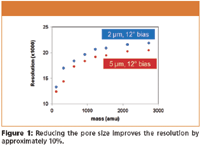Improving TOF Mass Resolution by Reducing Ion Detector Time Jitter
The resolution of time of flight (TOF) mass spectrometers continues to improve and attributes of the instrument that once were considered inconsequential have risen in importance as the push to higher and higher resolution continues.
Steve Ritzau, Paula Holmes, Paul Mitchell, and Bruce Laprade, PHOTONIS USA
The resolution of time of flight (TOF) mass spectrometers continues to improve and attributes of the instrument that once were considered inconsequential have risen in importance as the push to higher and higher resolution continues. While the significance of the speed of the detector pulse has always been a primary concern, there are other aspects of the ion detector that also affect the ultimate resolution. In this study, we examine the effect of the detector input surface geometry on the resolution of a TOF mass spectrometer and compare our measured results with values predicted by theory. Using several input configurations, we isolate the detector's effect on ion arrival time and quantify its contribution to the measured resolution.
Experimental Conditions
For these experiments, we utilized an UltraFast™ Bipolar TOF detector, which has a single microchannel plate (MCP) at the input surface and produces a sub-nanosecond pulse width, which is effectively independent of the MCP parameters. The detector was used to measure calibrant mass spectra in a commercially available orthogonal TOF instrument with an input MCP that had 5 μm diameter pores biased 12° with respect to the surface normal. No software corrections to peak shapes were utilized. The measurement was then repeated using the same detector hardware but with two different input MCPs mounted in the assembly; one with 5 μm pores and 19° bias angle and another with 2 μm pores and 12° bias angle. All measurements were made keeping the TOF parameters fixed except for small variations in the reflectron mirror voltage.
For each configuration, the global MCP flatness was also measured using a machine vision system. This system maps the focal plane deviation of the 25 mm diameter top surface of MCP after it has been mounted in the detector. The maximal focus plane deviation value for this detector is typically <15 μm, and was <8 μm for the MCPs in this study.

Figure 1
Results
Figure 1 illustrates how the reduction in pore size from 5 μm to 2 μm increased the mass resolution by 10% for masses of ~3000 amu. Figure 2 shows a 10% improvement in resolution when the bias angle is increased to 19º for these same high masses.
This improvement in resolution is due to a reduction in the ion penetration depth into the MCP. Combining these two effects, the 23.5 μm penetration depth of an MCP with 5 μm pore size and 12° bias angle could be reduced to 5.4 μm by utilizing 2 μm pore, 19° bias angle.

Figure 2
Additionally, we see no discernable change in overall sensitivity with the change in bias angle based on the limited sample of these individual MCPs. From our results we see that, with no other changes to the instrument, TOF mass resolution can be improved by:
- Controlling MCP global flatness
- Increasing MCP bias angle
- Reducing MCP pore size.

PHOTONIS USA
P.O. Box 1159, Sturbridge, MA 01566
tel. (800)648-1800; fax (508)347-3849
Email:
sales@usa.photonis.com
; Website:
www.photonis.com

The Benefits of Custom Bonded Silica
April 1st 2025Not all chromatography resins are created equal. Off-the-shelf chromatography resins might not always meet the rigorous purification requirements of biopharmaceutical manufacturing. Custom bonded silica from Grace can address a wide range of separation challenges, leading to real performance improvements. Discover more about the latest innovations in chromatography silica from Grace, including VYDAC® and DAVISIL®.
5 Things to Consider When Selecting a Chromatography Silica
April 1st 2025Particularly in the pharmaceutical industry, drug purity isn’t just a goal – it’s essential for achieving safety, stability and efficacy. However, purification is easier said than done, especially with challenging molecules like DNA and RNA “oligonucleotides,” due in large part to their diversity and the range of impurities that can be generated during production. Enter DAVISIL® chromatographic silica, with a wide range of pore diameters and particle sizes to meet your specific application, performance and sustainability requirements. Before you choose the chromatography resin for your next purification application, take a look at these 5 considerations.
Automating Protein Purification: Efficiency, Yield, and Reproducibility
March 27th 2025Recent advancements in automated protein purification stress the importance of efficiency, scalability, and yield consistency. This eBook compares different purification platforms, highlighting their impact on downstream applications and demonstrating how automation enhances throughput and process control.
MilliporeSigma: Ultrapure Water for Sensitive LC-MS Analysis of Pesticides
March 25th 2025The aim of the study was to illustrate the efficiency of Milli-Q® water purification systems in eliminating pesticides from tap water, thereby producing and delivering reliable and consistent-quality ultrapure water suitable for pesticides analysis














